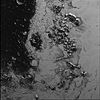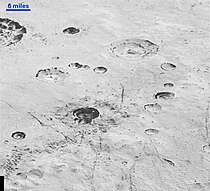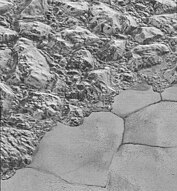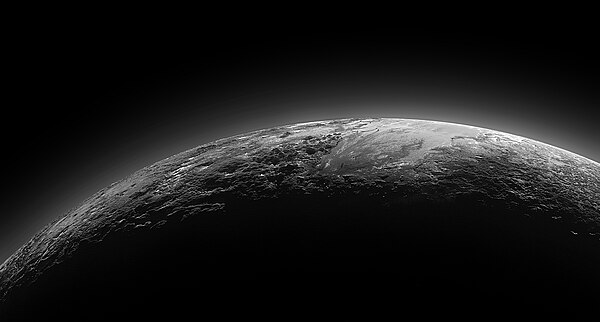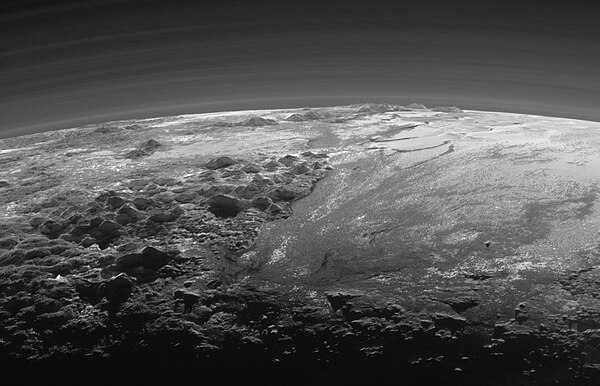Geography of Pluto: Difference between revisions
Praemonitus (talk | contribs) Too many photos for its length |
|||
| (19 intermediate revisions by 10 users not shown) | |||
| Line 1: | Line 1: | ||
{{Short description|none}} |
{{Short description|none}} |
||
{{Use dmy dates|date=July 2015}} |
{{Use dmy dates|date=July 2015}} |
||
{{Too many photos|date=November 2024}} |
|||
{{multiple image |
{{multiple image |
||
|direction=vertical |
|direction=vertical |
||
| Line 10: | Line 11: | ||
|footer=[[Pluto]] as viewed by the ''[[New Horizons]]'' [[spacecraft]]<br>(context; color; July 2015) |
|footer=[[Pluto]] as viewed by the ''[[New Horizons]]'' [[spacecraft]]<br>(context; color; July 2015) |
||
}} |
}} |
||
The '''geography of Pluto''' |
The '''geography of Pluto''' refers to the study and mapping of physical features across the [[dwarf planet]] [[Pluto]]. On 14 July 2015, the ''[[New Horizons]]'' [[spacecraft]] became the first spacecraft to [[planetary flyby|fly by]] Pluto.<ref name="NYT-20150714-kc">{{cite news |last=Chang |first=Kenneth |title=NASA's New Horizons Spacecraft Completes Flyby of Pluto |url=https://www.nytimes.com/2015/07/15/science/space/nasa-new-horizons-spacecraft-reaches-pluto.html |date=14 July 2015 |work=[[New York Times]] |access-date=14 July 2015 }}</ref><ref name="AP-20150714">{{cite news |last=Dunn |first=Marcia |title=Pluto close-up: Spacecraft makes flyby of icy, mystery world |url=http://apnews.excite.com/article/20150714/us-sci--pluto-1a20f848e7.html |date=14 July 2015 |work=[[AP News]] |access-date=14 July 2015 }}</ref> During its brief flyby, ''New Horizons'' made detailed geographical measurements and observations of Pluto and its [[Moons of Pluto|moons]].<ref name="NYT-20150706">{{cite news |last=Chang |first=Kenneth |title=Almost Time for Pluto's Close-Up |url=https://www.nytimes.com/2015/07/07/science/space/almost-time-for-plutos-close-up.html |date=6 July 2015 |work=[[New York Times]] |access-date=6 July 2015 }}</ref> |
||
==Coordinate system orientation== |
==Coordinate system orientation== |
||
{{Further|Poles of astronomical bodies}} |
{{Further|Poles of astronomical bodies}} |
||
Pluto may be defined as having [[retrograde rotation]] and an axial tilt of 60 degrees, or prograde rotation and a tilt of 120 degrees. Following the latter convention (the [[right-hand rule]]), the hemisphere currently in daylight is the northern one, with much of the southern hemisphere in darkness. This is the convention used by the [[International Astronomical Union]] (IAU) and the ''New Horizons'' team, and their maps put the sunlit hemisphere on top. However, older sources may define Pluto's rotation as retrograde and therefore the sunlit side as the southern hemisphere. East and |
Pluto may be defined as having [[retrograde rotation]] and an axial tilt of 60 degrees, or prograde rotation and a tilt of 120 degrees. Following the latter convention (the [[right-hand rule]]), the hemisphere currently in daylight is the northern one, with much of the southern hemisphere in darkness. This is the convention used by the [[International Astronomical Union]] (IAU) and the ''New Horizons'' team, and their maps put the sunlit hemisphere on top. However, older sources may define Pluto's rotation as retrograde and therefore the sunlit side as the southern hemisphere. East and West are also swapped between the two conventions.<ref>For example, {{cite web | title = Puzzling Seasons and Signs of Wind Found on Pluto | first=Robert Roy |last=Britt | work = Space.com | url = http://www.space.com/scienceastronomy/pluto_seasons_030709.html | date = 2003 | access-date = 26 March 2007 | archive-url=https://web.archive.org/web/20110109025459/http://www.space.com/scienceastronomy/pluto_seasons_030709.html | archive-date=9 January 2011}}</ref> |
||
The [[prime meridian]] of Pluto is defined as the longitude facing [[Charon (moon)|Charon]].<ref name="SWRI-MWB">{{cite web |last= |
The [[prime meridian]] of Pluto is defined as the longitude facing [[Charon (moon)|Charon]].<ref name="SWRI-MWB">{{cite web |last=Buie |first=Marc W. |title=Mapping the surface of Pluto and Charon |url=http://www.boulder.swri.edu/~buie/pluto/plutomap1.html |work=[[SWRI]] |access-date=19 July 2015 }}</ref> |
||
==Topographical features== |
==Topographical features== |
||
| Line 27: | Line 28: | ||
[[File:Tombaugh Regio.jpg|thumb|Tombaugh Regio, as viewed by ''[[New Horizons]]'' 13{{nbsp}}July 2015]] |
[[File:Tombaugh Regio.jpg|thumb|Tombaugh Regio, as viewed by ''[[New Horizons]]'' 13{{nbsp}}July 2015]] |
||
{{main|Tombaugh Regio|Sputnik Planitia}} |
{{main|Tombaugh Regio|Sputnik Planitia}} |
||
Tombaugh Regio (nicknamed "The Heart") is a large, light-colored topographical region, formed in the [[Heart (symbol)|shape of a heart]], named after the modern discoverer of Pluto, [[Clyde Tombaugh]]. The two top lobes of the heart are distinct geological features, both having a bright and whiteish appearance, with the western lobe (called ''[[Sputnik Planitia]]'' – a vast plain of [[solid nitrogen|nitrogen]] and other ices) being smoother than the eastern lobe.<ref>{{cite news|last1=Feltman|first1=Rachel|title=New data reveals that Pluto's heart is broken|url=https://www.washingtonpost.com/news/speaking-of-science/wp/2015/07/14/new-data-reveals-that-plutos-heart-is-broken/|newspaper=The Washington Post|access-date=14 July 2015|date=14 July 2015}}</ref> The heart is about {{convert|990|mi|km|disp=flip|abbr=on}} across. The region contains two {{convert|11,000|ft|m|abbr = on|order=flip}} |
|||
peaks composed of water-ice along its southwestern edge, ''[[Hillary Montes]]'' and ''[[Tenzing Montes]]''. The lack of craters in the region suggests that |
peaks composed of water-ice along its southwestern edge, ''[[Hillary Montes]]'' and ''[[Tenzing Montes]]''. The lack of craters in the region suggests that its surface is less than 100 million years old, hence the speculation that Pluto is probably geologically active.<ref>{{cite web|last1 = Orwig|first1 = Jessica|title = The first insanely close-up photos of Pluto reveal water on its surface|url = http://www.businessinsider.com/the-first-insanely-close-up-photos-of-pluto-reveal-water-on-its-surface-2015-7|work = Business Insider|access-date = 15 July 2015|date = 15 July 2015}}</ref> Subsequent data indicated that features near the western edges of the region (an area about the size of [[Texas]]) show evidence of "exotic ice flow", similar to melting glaciers, rich in methane, carbon monoxide, and nitrogen ices. Potentially recent glacial activity, near ''Cthulhu Macula'', is suggested by the presence of lighter-hued material overlaid on top of darker, more ancient portions; according to Lillian Gipson at NASA, "...In the southernmost region of the heart, adjacent to the dark equatorial region, it appears that ancient, heavily-cratered terrain (informally named “Cthulhu Regio”) has been invaded by much newer icy deposits."<ref>{{cite web|url=https://www.nasa.gov/feature/new-horizons-discovers-flowing-ices-on-pluto |title=New Horizons Discovers Flowing Ices on Pluto |date=24 July 2015|accessdate=2 March 2023|author=Gipson, Lillian|publisher=NASA}}</ref> |
||
===The Brass Knuckles=== |
===The Brass Knuckles=== |
||
[[File:Pluto-BrassKnuckles-20150716.jpg|thumb|The "Brass Knuckles" region of Pluto. Meng-p'o is at the zero meridian; to the east is the 'tail' of |
[[File:Pluto-BrassKnuckles-20150716.jpg|thumb|The "Brass Knuckles" region of Pluto. Meng-p'o is at the zero meridian; to the east is the 'tail' of Belton Regio. Note that the [[Safronov Regio]] is labeled as "Krun" in this image.]] |
||
A series of semi-regularly spaced dark spots with irregular boundaries are nicknamed the |
A series of semi-regularly spaced dark spots with irregular boundaries are nicknamed the [[brass knuckles|Brass Knuckles]]. They average about {{convert|300|mi|km|disp=flip|abbr=on}} in diameter and are located along the equator between the Heart and the tail of the Whale.<ref name="darkbelt">{{cite web|last1=Chang|first1=Kenneth|title=The Dark Belt Around Pluto|url=https://www.nytimes.com/interactive/projects/cp/summer-of-science-2015/latest/the-dark-belt-around-pluto|work=[[New York Times]]|access-date=14 July 2015|date=12 July 2015}}</ref><ref name="knuckles">{{cite news|last1=Feltman|first1=Rachel|title=Pluto shows mysterious spots in new NASA photos|url=https://www.washingtonpost.com/news/speaking-of-science/wp/2015/07/02/pluto-shows-mysterious-spots-in-new-nasa-photos/|newspaper=The Washington Post|access-date=14 July 2015|date=2 July 2015}}</ref> The brass knuckles are separated from one another by tall uplands. There are also many canyons running through them and through the surrounding mountains that are hundreds of miles long and several miles deep.<ref>{{Cite web |last = Keeter |first = Bill |title = Secrets Revealed from Pluto's 'Twilight Zone' |url = https://www.nasa.gov/feature/secrets-revealed-from-pluto-s-twilight-zone |date = 2 June 2016 |access-date = 30 August 2016 |publisher = [[NASA]] |archive-date = 18 October 2016 |archive-url = https://web.archive.org/web/20161018194425/http://www.nasa.gov/feature/secrets-revealed-from-pluto-s-twilight-zone/ |url-status = dead }}</ref> From west (south of Tombaugh Regio) to east (west of the Whale's tail), the Knuckles are:<ref>{{cite web|last1=Chang|first1=Kenneth|title=NASA's New Horizons Spacecraft Completes Flyby of Pluto|url=https://www.nytimes.com/2015/07/15/science/space/nasa-new-horizons-spacecraft-reaches-pluto.html|work=[[New York Times]]|access-date=14 July 2015|date=14 July 2015}}</ref><ref>{{cite magazine|last1=Rogers|first1=Adam|title=The New, Nerdy Mythology of Pluto's Place Names|url=https://www.wired.com/2015/07/new-nerdy-mythology-plutos-place-names/|magazine=Wired|access-date=14 July 2015|date=14 July 2015}}</ref> |
||
* [[Safronov Regio]] (formerly known as Krun Macula), after Russian astronomer [[Viktor Safronov]] |
|||
* [[Krun Macula]], after a [[Krun|lord of the underworld]] in the [[Mandaeism|Mandaean]] religion of southern Iraq |
|||
* [[Sharaf Regio]] (formerly known as Ala Macula), after Soviet astronomer Shafika Gil’mievna Sharaf |
|||
* [[Ala Macula]], after an [[Ala (odinani)|underworld and harvest deity]] of the [[Igbo people]] of eastern Nigeria |
|||
* [[Harrington Regio]] (formerly known as Balrog Macula), after American astronomer [[Robert Sutton Harrington]] |
|||
* [[Balrog Macula]], after a fictional [[Balrog|race of demons]] in [[J. R. R. Tolkien]]'s fantasy mythos |
|||
* [[Vucub-Came Macula]] and [[Hun-Came Macula]], after the two leading [[Maya death gods|death gods]] in the ''[[Popol Vuh]]'' text of the [[K'iche' people|K'iche']] Maya |
* [[Vucub-Came Macula]] and [[Hun-Came Macula]], after the two leading [[Maya death gods|death gods]] in the ''[[Popol Vuh]]'' text of the [[K'iche' people|K'iche']] Maya |
||
* [[Meng-p'o Macula]], after a [[Meng Po|goddess]] from [[Chinese Buddhism]]<ref>{{Cite web|last=Wallace |first=Sam Littlefair |title |
* [[Meng-p'o Macula]], after a [[Meng Po|goddess]] from [[Chinese Buddhism]]<ref>{{Cite web |last=Wallace |first=Sam Littlefair |title=NASA gives Buddhist nickname to region of Pluto |work=Lion's Roar |url=http://www.lionsroar.com/nasa-informally-names-plutonian-region-after-buddhist-deity/ |date=15 July 2015 |access-date=23 July 2015 |archive-date=15 March 2016 |archive-url=https://web.archive.org/web/20160315013410/http://www.lionsroar.com/nasa-informally-names-plutonian-region-after-buddhist-deity/ |url-status=dead }}</ref> who caused the dead to forget their past lives |
||
=== |
===Belton Regio=== |
||
{{main| |
{{main|Belton Regio}} |
||
Belton Regio (formerly called ''Cthulhu Macula'' or ''Cthulhu Regio''),<ref name = "Pluto System after New Horizons" /> nicknamed ''The Whale'' after its shape, is an elongated, dark region along Pluto's equator named in honor of astronomer [[Michael J. Belton]],<ref name="beltonnaming"/> and was informally named after the fictional [[Cthulhu|deity]] from the works of [[H. P. Lovecraft]]. It is {{convert|1860|mi|km|disp=flip|abbr=on}} long and is the largest dark feature on Pluto.<ref name="whale">{{cite news|last1=Feltman|first1=Rachel|title=New map of Pluto reveals a 'whale' and a 'donut'|url=https://www.washingtonpost.com/news/speaking-of-science/wp/2015/07/08/new-map-of-pluto-reveals-a-whale-and-a-donut/|newspaper=The Washington Post|access-date=14 July 2015|date=8 July 2015}}</ref> It is the largest of the dark regions (''Brass Knuckles'') that span Pluto's equator.<ref name = "Pluto System after New Horizons">{{Cite journal|last1=Stern |first1=S. A. |last2=Grundy |first2=W. |last3=McKinnon |first3=W. B. |last4=Weaver |first4=H. A. |last5=Young |first5=L. A.|title=The Pluto System After New Horizons|journal=Annual Review of Astronomy and Astrophysics |year=2018 |volume=56 |pages=357–392 |doi=10.1146/annurev-astro-081817-051935 |arxiv=1712.05669|bibcode=2018ARA&A..56..357S |s2cid=119072504 }}</ref> The dark color of the area is speculated to be the result of a "tar" made of complex hydrocarbons called [[tholin]]s covering the surface, formed from methane and nitrogen in the |
|||
atmosphere interacting with ultraviolet light and cosmic rays.<ref>{{Cite web|title = Why the Dark Spots on Pluto?|url = http://thespacewriter.com/wp/2015/07/03/why-the-dark-spots-on-pluto/ |date=3 July 2015 |access-date = 23 July 2015|last = Petersen|first = C. C.|website = TheSpacewriter's Ramblings}}</ref><ref>{{Cite web|title = Strange Spots on Pluto May be Tar and Frost|url = http://www.space.com/8313-strange-spots-pluto-tar-frost.html |date=29 April 2010 |access-date = 23 July 2015|website = Space.com|last = Moskowitz|first = Clara}}</ref><ref>{{Cite web|title = Pluto's bright heart and Charon's dark spot revealed in HD {{!}} Astronomy.com|url = http://www.astronomy.com/news/2015/07/plutos-heart-revealed-as-mountainous-tombaugh-regio |date=15 July 2015 |access-date = 23 July 2015 |website = Astronomy Magazine|last = Betz|first = Eric}}</ref> |
atmosphere interacting with ultraviolet light and cosmic rays.<ref>{{Cite web|title = Why the Dark Spots on Pluto?|url = http://thespacewriter.com/wp/2015/07/03/why-the-dark-spots-on-pluto/ |date=3 July 2015 |access-date = 23 July 2015|last = Petersen|first = C. C.|website = TheSpacewriter's Ramblings}}</ref><ref>{{Cite web|title = Strange Spots on Pluto May be Tar and Frost|url = http://www.space.com/8313-strange-spots-pluto-tar-frost.html |date=29 April 2010 |access-date = 23 July 2015|website = Space.com|last = Moskowitz|first = Clara}}</ref><ref>{{Cite web|title = Pluto's bright heart and Charon's dark spot revealed in HD {{!}} Astronomy.com|url = http://www.astronomy.com/news/2015/07/plutos-heart-revealed-as-mountainous-tombaugh-regio |date=15 July 2015 |access-date = 23 July 2015 |website = Astronomy Magazine|last = Betz|first = Eric}}</ref> |
||
The presence of a large number of craters within Cthulhu indicates that it is perhaps billions of years old, in contrast to the adjacent bright, craterless [[Sputnik Planitia]], which may be as little as 100 million years old.<ref>{{Cite web|last=Talbert|first=Tricia |title = NASA's New Horizons Finds Second Mountain Range in Pluto's 'Heart'|url = http://www.nasa.gov/image-feature/nasa-s-new-horizons-finds-second-mountain-range-in-pluto-s-heart |date=21 July 2015 |access-date = 23 July 2015 |publisher = [[NASA]]}}</ref> |
The presence of a large number of craters within Cthulhu indicates that it is perhaps billions of years old, in contrast to the adjacent bright, craterless [[Sputnik Planitia]], which may be as little as 100 million years old.<ref>{{Cite web|last=Talbert|first=Tricia |title = NASA's New Horizons Finds Second Mountain Range in Pluto's 'Heart'|url = http://www.nasa.gov/image-feature/nasa-s-new-horizons-finds-second-mountain-range-in-pluto-s-heart |date=21 July 2015 |access-date = 23 July 2015 |publisher = [[NASA]]}}</ref> |
||
| Line 48: | Line 49: | ||
===The Donut=== |
===The Donut=== |
||
[[File:NH-Pluto-Map-DonutWhaleHeart-20150703-Crop.jpg|thumb|The "Donut" is cradled in the Tail of The Whale]] |
[[File:NH-Pluto-Map-DonutWhaleHeart-20150703-Crop.jpg|thumb|The "Donut" is cradled in the Tail of The Whale]] |
||
A bright, ring-shaped feature about {{convert|350|km|mi|abbr=on}} across located near the tail of the "Whale" in low-resolution images is nicknamed the " |
A bright, ring-shaped feature about {{convert|350|km|mi|abbr=on}} across located near the tail of the "Whale" in low-resolution images is nicknamed the "Donut".<ref name="NASA-20150707">{{cite web |last=Talbert |first=Tricia |title=New Horizons Map of Pluto: The Whale and the Donut |url=https://www.nasa.gov/feature/new-horizons-map-of-pluto-the-whale-and-the-donut |publisher=[[NASA]] |date=7 July 2015 |access-date=19 September 2015 |archive-date=12 February 2017 |archive-url=https://web.archive.org/web/20170212203653/https://www.nasa.gov/feature/new-horizons-map-of-pluto-the-whale-and-the-donut/ |url-status=dead }}</ref> It does not appear as a ring in higher-resolution images. |
||
===Dune fields=== |
===Dune fields=== |
||
[[File:PIA20198-Pluto-SputnikPlanum-Mountains-20150714.jpg|thumb|Dune fields in Sputnik Planitia near |
[[File:PIA20198-Pluto-SputnikPlanum-Mountains-20150714.jpg|thumb|Dune fields in Sputnik Planitia near the foothills of Al-Idrisi Montes]] |
||
In the Western part of Sputnik Planitia near [[Al-Idrisi Montes]] there are fields of [[transverse dunes]] formed by the winds, which blow from the center of Sputnik Planitia in the direction of surrounding mountings. The dune wavelengths are in the range of 0.4–1 km and they likely consist of methane ice particles 200–300 μm in size. The particles are lofted above the surface when the nitrogen ice [[sublimation (phase transition)|sublimates]] under [[solar irradiation]]. After that they are moved by gentle winds blowing with 1–10 m/s speeds despite generally low atmospheric pressure of about 15 μbar.<ref name=Brown2018>{{cite journal|doi=10.1126/science.aao2975|pmid=29853681|title=Dunes on Pluto|journal=Science|volume=360|issue=6392|pages=992–997|year=2018|last1=Telfer|first1=Matt W|last2=Parteli|first2=Eric J R|last3=Radebaugh|first3=Jani|last4=Beyer|first4=Ross A|last5=Bertrand|first5=Tanguy|last6=Forget|first6=François|last7=Nimmo|first7=Francis|last8=Grundy|first8=Will M|last9=Moore|first9=Jeffrey M|last10=Stern|first10=S Alan|last11=Spencer|first11=John|last12=Lauer|first12=Tod R|last13=Earle|first13=Alissa M|last14=Binzel|first14=Richard P|last15=Weaver|first15=Hal A|last16=Olkin|first16=Cathy B|last17=Young|first17=Leslie A|last18=Ennico|first18=Kimberly|last19=Runyon|first19=Kirby|bibcode=2018Sci...360..992T|doi-access=free}}</ref> |
In the Western part of Sputnik Planitia near [[Al-Idrisi Montes]], there are fields of [[transverse dunes]] formed by the winds, which blow from the center of Sputnik Planitia in the direction of surrounding mountings. The dune wavelengths are in the range of 0.4–1 km and they likely consist of methane ice particles 200–300 μm in size. The particles are lofted above the surface when the nitrogen ice [[sublimation (phase transition)|sublimates]] under [[solar irradiation]]. After that, they are moved by gentle winds blowing with 1–10 m/s speeds despite generally low atmospheric pressure of about 15 μbar.<ref name=Brown2018>{{cite journal|doi=10.1126/science.aao2975|pmid=29853681|title=Dunes on Pluto|journal=Science|volume=360|issue=6392|pages=992–997|year=2018|last1=Telfer|first1=Matt W|last2=Parteli|first2=Eric J R|last3=Radebaugh|first3=Jani|last4=Beyer|first4=Ross A|last5=Bertrand|first5=Tanguy|last6=Forget|first6=François|last7=Nimmo|first7=Francis|last8=Grundy|first8=Will M|last9=Moore|first9=Jeffrey M|last10=Stern|first10=S Alan|last11=Spencer|first11=John|last12=Lauer|first12=Tod R|last13=Earle|first13=Alissa M|last14=Binzel|first14=Richard P|last15=Weaver|first15=Hal A|last16=Olkin|first16=Cathy B|last17=Young|first17=Leslie A|last18=Ennico|first18=Kimberly|last19=Runyon|first19=Kirby|bibcode=2018Sci...360..992T|doi-access=free}}</ref> |
||
==Nomenclature== |
==Nomenclature== |
||
| Line 58: | Line 59: | ||
The [[Working Group for Planetary System Nomenclature]] of the International Astronomical Union (IAU) is responsible for assigning official names to surface features on Pluto. On 7 September 2017, the first 14 names were officially approved by the IAU.<ref name="name approval"/> |
The [[Working Group for Planetary System Nomenclature]] of the International Astronomical Union (IAU) is responsible for assigning official names to surface features on Pluto. On 7 September 2017, the first 14 names were officially approved by the IAU.<ref name="name approval"/> |
||
As of August 2015, the ''New Horizons'' science team derives ''informal'' names from the following themes: explorers, space missions, spacecraft, scientists and engineers; fictional explorers, travellers, vessels, destinations and origins; authors and artists who have envisioned exploration; and fictional [[underworld]]s, underworld beings, and travellers to the underworld. The ''New Horizons'' science team invited members of the public to propose names and vote on them before the spacecraft's arrival.<ref name=nominatename>{{cite web |
As of August 2015, the ''New Horizons'' science team derives ''informal'' names from the following themes: explorers, space missions, spacecraft, scientists and engineers; fictional explorers, travellers, vessels, destinations, and origins; authors and artists who have envisioned exploration; and fictional [[underworld]]s, underworld beings, and travellers to the underworld. The ''New Horizons'' science team invited members of the public to propose names and vote on them before the spacecraft's arrival.<ref name=nominatename>{{cite web |
||
|url = http://www.ourpluto.org/nominate |
|url = http://www.ourpluto.org/nominate |
||
|title = Nominate a Name! |
|title = Nominate a Name! |
||
| Line 69: | Line 70: | ||
[[File:Pluto-Map-Annotated.jpg|thumb|center|800px|{{center|[[List of geological features on Pluto|Informally named geographic features]]}}]] |
[[File:Pluto-Map-Annotated.jpg|thumb|center|800px|{{center|[[List of geological features on Pluto|Informally named geographic features]]}}]] |
||
[[File:PIA21944 - First Official Pluto Feature Names.jpg|thumb|center|600px|{{center|A map of Pluto showing the feature names officially approved by the [[International Astronomical Union|IAU]] on 7 September 2017.<ref name="name approval"/>}}]] |
[[File:PIA21944 - First Official Pluto Feature Names.jpg|thumb|center|600px|{{center|A map of Pluto showing the feature names officially approved by the [[International Astronomical Union|IAU]] on 7 September 2017.<ref name="name approval"/>}}]] |
||
==Machine-Learning Techniques Applied to Surface Mapping== |
|||
There has been a recent increased focus on developing machine learning algorithms and techniques that are able to model complex structures using limited reference or training data.<ref>{{Cite journal |last1=Emran |first1=A. |last2=Ore |first2=C. M. Dalle |last3=Ahrens |first3=C. J. |last4=Khan |first4=M. K. H. |last5=Chevrier |first5=V. F. |last6=Cruikshank |first6=D. P. |date=2023-01-15 |title=Pluto's Surface Mapping using Unsupervised Learning from Near-Infrared Observations of LEISA/Ralph |journal=The Planetary Science Journal |volume=4 |issue=1 |page=15 |doi=10.3847/PSJ/acb0cc |arxiv=2301.06027|bibcode=2023PSJ.....4...15E |s2cid=255942664 }}</ref> The dwarf planet Pluto has been a niche topic for the exploration of these practices. It is unique in that we have very limited visual and near-infrared data, only from NASA's New Horizons Mission probe that performed a flyby and collected the first up-close data on the planet in 2015 [[New Horizons]]. From this mission and ground-based telescopes, there is confirmation of the presence of both volatiles and non-volatiles on the surface of Pluto.<ref>{{Cite journal |last1=Stern |first1=S. Alan |last2=Grundy |first2=William M. |last3=McKinnon |first3=William B. |last4=Weaver |first4=Harold A. |last5=Young |first5=Leslie A. |date=2018-09-14 |title=The Pluto System After New Horizons |url=https://www.annualreviews.org/doi/10.1146/annurev-astro-081817-051935 |journal=Annual Review of Astronomy and Astrophysics |language=en |volume=56 |issue=1 |pages=357–392 |doi=10.1146/annurev-astro-081817-051935 |arxiv=1712.05669 |bibcode=2018ARA&A..56..357S |s2cid=119072504 |issn=0066-4146}}</ref> Given its limited data, Pluto has been a recent test case for machine learning algorithms to be applied to the modeling of a planetary surface. |
|||
One recent study that applied these techniques to Pluto surface mapping was done using an unsupervised learning model based only on near-infrared data from the Linear Etalon Imaging Spectral Array (LEISA) and Ralph instruments collected during NASA's New Horizon Mission flyby in 2015.<ref>{{Citation |last1=Weaver |first1=H. A. |title=Overview of the New Horizons Science Payload |date=2009 |url=http://link.springer.com/10.1007/978-0-387-89518-5_5 |work=New Horizons |pages=75–91 |editor-last=Russell |editor-first=C. T. |access-date=2023-05-15 |place=New York, NY |publisher=Springer New York |language=en |doi=10.1007/978-0-387-89518-5_5 |isbn=978-0-387-89517-8 |last2=Gibson |first2=W. C. |last3=Tapley |first3=M. B. |last4=Young |first4=L. A. |last5=Stern |first5=S. A.}}</ref> Researchers used a principal component reduced Gaussian Mixture Model (GMM) to create a more comprehensive map of Pluto. The initial goals were to investigate the distribution of both volatiles and non-volatiles of interest across the planet's surface as well as numerically represent the likelihood of each elemental compound in an individual pixel in the dataset. All of this is done with the GMM only analyzing the average infrared spectra from the LEISA and Ralph datasets. |
|||
The GMM excels at pattern recognition and creating and assigning group labels by approaching given data with a probabilistic approach that assumes all data points are the result of a finite normal distribution without parameter information.<ref>{{Cite journal |last1=Patel |first1=Eva |last2=Kushwaha |first2=Dharmender Singh |date=2020-01-01 |title=Clustering Cloud Workloads: K-Means vs Gaussian Mixture Model |url=https://www.sciencedirect.com/science/article/pii/S1877050920309820 |journal=Procedia Computer Science |series=Third International Conference on Computing and Network Communications (CoCoNet'19) |language=en |volume=171 |pages=158–167 |doi=10.1016/j.procs.2020.04.017 |s2cid=226613207 |issn=1877-0509}}</ref> To contrast, a similar styled algorithm that GMM was designed to improve on, the K-Means Clustering, performs significantly worse due to its process requiring strict categorization that forces data points to be classified into only one group. Whereas the GMM approach allows for overlapping data point categorization using a probability density function that creates a much more flexible and adaptive model. Because of this, one downside to the GMM approach is that it requires lower dimensional data due to the fact that it must store probability values for each individual data point. Therefore, hyperspectral data should be split up and GMM applied to only a few bands at a time, hence why this initial study only looked at near-infrared bands. This downside does not exclude higher dimensionality, but the computational rigor associated with the required parameter storage must be considered and is only acceptable for large, high-performing computing resources. |
|||
In this case, researchers further simplified the GMM approach by using principal component analysis to reduce the dimensionality of a dataset while maintaining the original variance and large-scale characteristics of the data. |
|||
Although only infrared data from two instruments aboard a single spacecraft that performed a flyby were used, the Gaussian Mixture Model yielded a significant ability to help create a more comprehensive map of Pluto's surface features. The exact same unsupervised model with the same goals can be applied to help understand the chemical compound distribution for the surfaces of many other planetary bodies in the solar system that feature limited and poorly labeled or completely unlabelled data. {{clear}} |
|||
==Gallery== |
==Gallery== |
||
[[File:PIA20658-Pluto-Global-released20160502.jpg|thumb|center|800px|{{center|Global black and white map of Pluto, with [[Sputnik Planitia]] just above center (released 2 May 2016)}}]] |
[[File:PIA20658-Pluto-Global-released20160502.jpg|thumb|center|800px|{{center|Global black and white map of Pluto, with [[Sputnik Planitia]] just above center (released 2 May 2016)}}]] |
||
| Line 90: | Line 80: | ||
|File:Pluto-NewHorizons-Annotated-20150711.jpg|{{center|{{small|Pluto viewed by ''New Horizons''<br>(annotated; 11 July 2015).}}}} |
|File:Pluto-NewHorizons-Annotated-20150711.jpg|{{center|{{small|Pluto viewed by ''New Horizons''<br>(annotated; 11 July 2015).}}}} |
||
}} |
}} |
||
[[File:PIA14457-Pluto-NewHorizons-BestResolution-Context-20160527.jpg|thumb|165px|right|{{center|Pluto |
[[File:PIA14457-Pluto-NewHorizons-BestResolution-Context-20160527.jpg|thumb|165px|right|{{center|Pluto – Best Resolution<br>Context}}]] |
||
[[File:PIA14458-Pluto-NewHorizons-BestResolution-20150714-released20160527.jpg|thumb|165px|right|{{center|Best resolution mosaic, showing part of [[Sputnik Planitia]] and related terrain<br>([[:File:PIA14457-Pluto-NewHorizons-BestResolution-Context-20160527.jpg|context image]])<br>(released 27 May 2016)}}]] |
[[File:PIA14458-Pluto-NewHorizons-BestResolution-20150714-released20160527.jpg|thumb|165px|right|{{center|Best resolution mosaic, showing part of [[Sputnik Planitia]] and related terrain<br>([[:File:PIA14457-Pluto-NewHorizons-BestResolution-Context-20160527.jpg|context image]])<br>(released 27 May 2016)}}]] |
||
{{Gallery |align=left |width=125 |
{{Gallery |align=left |width=125 |
||
| Line 101: | Line 91: | ||
{{Gallery|align=left |width=225 |
{{Gallery|align=left |width=225 |
||
|File:NH-Pluto-SputnikPlanum-20150714-v1.jpg|{{center|{{small|[[Sputnik Planitia]] – [[Hillary Montes]] and [[Tenzing Montes]] are boxed<br>(context; 14{{nbsp}}July 2015).}}}} |
|File:NH-Pluto-SputnikPlanum-20150714-v1.jpg|{{center|{{small|[[Sputnik Planitia]] – [[Hillary Montes]] and [[Tenzing Montes]] are boxed<br>(context; 14{{nbsp}}July 2015).}}}} |
||
|File:PIA19936 - Sputnik Planum region on Pluto.jpg|{{center|{{small|[[Sputnik Planitia]] |
|File:PIA19936 - Sputnik Planum region on Pluto.jpg|{{center|{{small|[[Sputnik Planitia]] – mosaic of closeup images<br>(context; 14{{nbsp}}July 2015/10{{nbsp}}September 2015).}}}} |
||
|File:Troughs in Sputnik Planum by LORRI - crop of PIA19936.jpg|{{center|{{small|Troughs in southern [[Sputnik Planitia]] ([[c:File:PIA19936 crop - context for Troughs in Sputnik Planum by LORRI.jpg|context]]) in the center left of [[Tombaugh Regio]], representing convection cell margins. Dark spots in the troughs at lower left are pits.<ref name="NYT-20150717-kc3">{{cite news |last=Chang |first=Kenneth |title=Pluto terrain yields big surprises in New Horizons images |url=https://www.nytimes.com/2015/07/18/science/space/pluto-terrain-yields-big-surprises-in-new-horizons-images.html |date=17 July 2015 |work=[[New York Times]] |access-date=17 July 2015 }}</ref>}}}} |
|File:Troughs in Sputnik Planum by LORRI - crop of PIA19936.jpg|{{center|{{small|Troughs in southern [[Sputnik Planitia]] ([[c:File:PIA19936 crop - context for Troughs in Sputnik Planum by LORRI.jpg|context]]) in the center left of [[Tombaugh Regio]], representing convection cell margins. Dark spots in the troughs at lower left are pits.<ref name="NYT-20150717-kc3">{{cite news |last=Chang |first=Kenneth |title=Pluto terrain yields big surprises in New Horizons images |url=https://www.nytimes.com/2015/07/18/science/space/pluto-terrain-yields-big-surprises-in-new-horizons-images.html |date=17 July 2015 |work=[[New York Times]] |access-date=17 July 2015 }}</ref>}}}} |
||
}} |
}} |
||
{{Gallery|align=left |width=100 |
{{Gallery|align=left |width=100 |
||
|File:Global-LORRI-PlutoMosaic-TrueColor-Hillary-Norgay-20150714.jpg|{{center|{{small|Pluto |
|File:Global-LORRI-PlutoMosaic-TrueColor-Hillary-Norgay-20150714.jpg|{{center|{{small|Pluto – [[Hillary Montes]] and [[Tenzing Montes]] are boxed<br>(context; 14{{nbsp}}July 2015).}}}} |
||
|File:NH-Pluto-SputnikPlanum-HillaryMontes-NorgayMontes-20150714.jpg|{{center|{{small|[[Hillary Montes]] and [[Tenzing Montes]]<br>(14{{nbsp}}July 2015).<ref name="NASA-20150724-lg">{{cite web |last=Gipson |first=Lillian |title=New Horizons Discovers Flowing Ices on Pluto |url=http://www.nasa.gov/feature/new-horizons-discovers-flowing-ices-on-pluto |date=24 July 2015 |publisher=[[NASA]] |access-date=24 July 2015 }}</ref>}}}} |
|File:NH-Pluto-SputnikPlanum-HillaryMontes-NorgayMontes-20150714.jpg|{{center|{{small|[[Hillary Montes]] and [[Tenzing Montes]]<br>(14{{nbsp}}July 2015).<ref name="NASA-20150724-lg">{{cite web |last=Gipson |first=Lillian |title=New Horizons Discovers Flowing Ices on Pluto |url=http://www.nasa.gov/feature/new-horizons-discovers-flowing-ices-on-pluto |date=24 July 2015 |publisher=[[NASA]] |access-date=24 July 2015 |archive-date=17 March 2016 |archive-url=https://web.archive.org/web/20160317050557/http://www.nasa.gov/feature/new-horizons-discovers-flowing-ices-on-pluto/ |url-status=dead }}</ref>}}}} |
||
|File:15-152-Pluto-NewHorizons-HighResolution-20150714-IFV.jpg|{{center|{{small|[[Tenzing Montes]] south of [[Tombaugh Regio]]<br>(14{{nbsp}}July 2015).<ref name="NYT-20150715-kc2">{{cite news |last=Chang |first=Kenneth |title=Pluto as New Horizons Saw It: Up Close and Personal |url=https://www.nytimes.com/2015/07/16/science/pluto-flyby-photos-reveal-mountains.html |date=15 July 2015 |work=[[New York Times]] |access-date=15 July 2015 }}</ref>}}}} |
|File:15-152-Pluto-NewHorizons-HighResolution-20150714-IFV.jpg|{{center|{{small|[[Tenzing Montes]] south of [[Tombaugh Regio]]<br>(14{{nbsp}}July 2015).<ref name="NYT-20150715-kc2">{{cite news |last=Chang |first=Kenneth |title=Pluto as New Horizons Saw It: Up Close and Personal |url=https://www.nytimes.com/2015/07/16/science/pluto-flyby-photos-reveal-mountains.html |date=15 July 2015 |work=[[New York Times]] |access-date=15 July 2015 }}</ref>}}}} |
||
|File:NH-Pluto-TombaughRegio-MountainRange-20150714-IFV.jpg|{{center|{{small|[[Hillary Montes]] southwest of [[Tombaugh Regio]]<br>(14{{nbsp}} July 2015).}}}} |
|File:NH-Pluto-TombaughRegio-MountainRange-20150714-IFV.jpg|{{center|{{small|[[Hillary Montes]] southwest of [[Tombaugh Regio]]<br>(14{{nbsp}} July 2015).}}}} |
||
|File:PIA20361-Pluto-WrightMons-20150714.jpg|{{center|{{small|Pluto |
|File:PIA20361-Pluto-WrightMons-20150714.jpg|{{center|{{small|Pluto – [[Wright Mons]]<br>(context; 14{{nbsp}}July 2015).}}}} |
||
|File:PIA20733-Pluto-KrunMaculaHighlands-20150714.jpg|{{center|{{small|Pluto |
|File:PIA20733-Pluto-KrunMaculaHighlands-20150714.jpg|{{center|{{small|Pluto – Krun Macula<br>(context; 14{{nbsp}}July 2015).}}}} |
||
}} |
}} |
||
[[File:PIA20473-Pluto-NorthPole-FrozenCanyons-Released20160227.jpg|thumb|left|500px|{{center|Pluto |
[[File:PIA20473-Pluto-NorthPole-FrozenCanyons-Released20160227.jpg|thumb|left|500px|{{center|Pluto – North Pole – Frozen Canyons}}]] |
||
{{multiple image |header=Pluto |
{{multiple image |header=Pluto – highest-resolution images |header_align=center |caption_align=center |align=left |width= |direction=horizontal |
||
|image1=PIA20200-Pluto-BurneyBasin-CratersPlains-20150714.jpg |
|image1=PIA20200-Pluto-BurneyBasin-CratersPlains-20150714.jpg |
||
|caption1=Burney Basin – more northerly |
|caption1=Burney Basin – more northerly |
||
| Line 133: | Line 123: | ||
|width2= |
|width2= |
||
|caption2= |
|caption2= |
||
|footer=[[Pluto]] |
|footer=[[Pluto]] – [[Tenzing Montes]] (left-foreground); [[Hillary Montes]] (left-skyline); [[Sputnik Planitia]] (right)<br>Near-sunset view includes several layers of [[Atmosphere of Pluto|atmospheric haze]]. |
||
|footer_align = center |
|footer_align = center |
||
}} |
}} |
||
| Line 153: | Line 143: | ||
==References== |
==References== |
||
{{Reflist| |
{{Reflist|2|refs= |
||
<ref name="beltonnaming">{{Cite web |date=2023-09-22 |title=Two Names Approved for Pluto: Belton Regio and Safronov Regio {{!}} USGS Astrogeology Science Center |url=https://astrogeology.usgs.gov/news/nomenclature/two-names-approved-for-pluto-belton-regio-and-safronov-regio |archive-url=https://web.archive.org/web/20231201033039/https://astrogeology.usgs.gov/news/nomenclature/two-names-approved-for-pluto-belton-regio-and-safronov-regio |archive-date=2023-12-01 |access-date=2023-09-27 |website=astrogeology.usgs.gov}}</ref> |
|||
}} |
|||
==External links== |
==External links== |
||
Latest revision as of 15:50, 23 November 2024
This article contains too many pictures for its overall length. (November 2024) |
The geography of Pluto refers to the study and mapping of physical features across the dwarf planet Pluto. On 14 July 2015, the New Horizons spacecraft became the first spacecraft to fly by Pluto.[1][2] During its brief flyby, New Horizons made detailed geographical measurements and observations of Pluto and its moons.[3]
Coordinate system orientation
[edit]Pluto may be defined as having retrograde rotation and an axial tilt of 60 degrees, or prograde rotation and a tilt of 120 degrees. Following the latter convention (the right-hand rule), the hemisphere currently in daylight is the northern one, with much of the southern hemisphere in darkness. This is the convention used by the International Astronomical Union (IAU) and the New Horizons team, and their maps put the sunlit hemisphere on top. However, older sources may define Pluto's rotation as retrograde and therefore the sunlit side as the southern hemisphere. East and West are also swapped between the two conventions.[4]
The prime meridian of Pluto is defined as the longitude facing Charon.[5]
Topographical features
[edit]
The following names were originally proposed by the New Horizons discovery team. These names were variously taken from historical figures involved in the study of Pluto, notable space exploration missions, and a variety of chthonic deities or demons, some from ancient mythology and others from modern popular culture. While several of these names have been canonized by the IAU as of 2017,[6] most remain informal classifications that have yet to be considered.
Tombaugh Regio
[edit]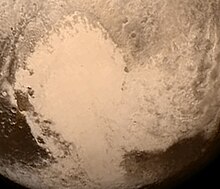
Tombaugh Regio (nicknamed "The Heart") is a large, light-colored topographical region, formed in the shape of a heart, named after the modern discoverer of Pluto, Clyde Tombaugh. The two top lobes of the heart are distinct geological features, both having a bright and whiteish appearance, with the western lobe (called Sputnik Planitia – a vast plain of nitrogen and other ices) being smoother than the eastern lobe.[7] The heart is about 1,590 km (990 mi) across. The region contains two 3,400 m (11,000 ft) peaks composed of water-ice along its southwestern edge, Hillary Montes and Tenzing Montes. The lack of craters in the region suggests that its surface is less than 100 million years old, hence the speculation that Pluto is probably geologically active.[8] Subsequent data indicated that features near the western edges of the region (an area about the size of Texas) show evidence of "exotic ice flow", similar to melting glaciers, rich in methane, carbon monoxide, and nitrogen ices. Potentially recent glacial activity, near Cthulhu Macula, is suggested by the presence of lighter-hued material overlaid on top of darker, more ancient portions; according to Lillian Gipson at NASA, "...In the southernmost region of the heart, adjacent to the dark equatorial region, it appears that ancient, heavily-cratered terrain (informally named “Cthulhu Regio”) has been invaded by much newer icy deposits."[9]
The Brass Knuckles
[edit]
A series of semi-regularly spaced dark spots with irregular boundaries are nicknamed the Brass Knuckles. They average about 480 km (300 mi) in diameter and are located along the equator between the Heart and the tail of the Whale.[10][11] The brass knuckles are separated from one another by tall uplands. There are also many canyons running through them and through the surrounding mountains that are hundreds of miles long and several miles deep.[12] From west (south of Tombaugh Regio) to east (west of the Whale's tail), the Knuckles are:[13][14]
- Safronov Regio (formerly known as Krun Macula), after Russian astronomer Viktor Safronov
- Sharaf Regio (formerly known as Ala Macula), after Soviet astronomer Shafika Gil’mievna Sharaf
- Harrington Regio (formerly known as Balrog Macula), after American astronomer Robert Sutton Harrington
- Vucub-Came Macula and Hun-Came Macula, after the two leading death gods in the Popol Vuh text of the K'iche' Maya
- Meng-p'o Macula, after a goddess from Chinese Buddhism[15] who caused the dead to forget their past lives
Belton Regio
[edit]Belton Regio (formerly called Cthulhu Macula or Cthulhu Regio),[16] nicknamed The Whale after its shape, is an elongated, dark region along Pluto's equator named in honor of astronomer Michael J. Belton,[17] and was informally named after the fictional deity from the works of H. P. Lovecraft. It is 2,990 km (1,860 mi) long and is the largest dark feature on Pluto.[18] It is the largest of the dark regions (Brass Knuckles) that span Pluto's equator.[16] The dark color of the area is speculated to be the result of a "tar" made of complex hydrocarbons called tholins covering the surface, formed from methane and nitrogen in the atmosphere interacting with ultraviolet light and cosmic rays.[19][20][21] The presence of a large number of craters within Cthulhu indicates that it is perhaps billions of years old, in contrast to the adjacent bright, craterless Sputnik Planitia, which may be as little as 100 million years old.[22]
The Donut
[edit]
A bright, ring-shaped feature about 350 km (220 mi) across located near the tail of the "Whale" in low-resolution images is nicknamed the "Donut".[23] It does not appear as a ring in higher-resolution images.
Dune fields
[edit]
In the Western part of Sputnik Planitia near Al-Idrisi Montes, there are fields of transverse dunes formed by the winds, which blow from the center of Sputnik Planitia in the direction of surrounding mountings. The dune wavelengths are in the range of 0.4–1 km and they likely consist of methane ice particles 200–300 μm in size. The particles are lofted above the surface when the nitrogen ice sublimates under solar irradiation. After that, they are moved by gentle winds blowing with 1–10 m/s speeds despite generally low atmospheric pressure of about 15 μbar.[24]
Nomenclature
[edit]The Working Group for Planetary System Nomenclature of the International Astronomical Union (IAU) is responsible for assigning official names to surface features on Pluto. On 7 September 2017, the first 14 names were officially approved by the IAU.[6]
As of August 2015, the New Horizons science team derives informal names from the following themes: explorers, space missions, spacecraft, scientists and engineers; fictional explorers, travellers, vessels, destinations, and origins; authors and artists who have envisioned exploration; and fictional underworlds, underworld beings, and travellers to the underworld. The New Horizons science team invited members of the public to propose names and vote on them before the spacecraft's arrival.[25]
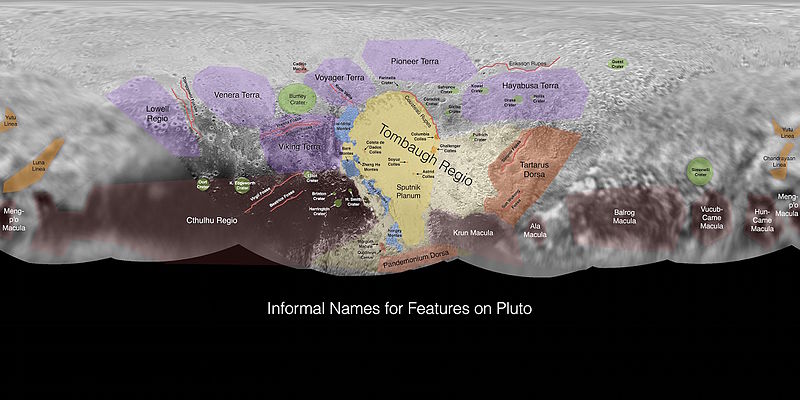

Gallery
[edit]

Context

(context image)
(released 27 May 2016)
-
Sputnik Planitia – Hillary Montes and Tenzing Montes are boxed
(context; 14 July 2015). -
Sputnik Planitia – mosaic of closeup images
(context; 14 July 2015/10 September 2015). -
Troughs in southern Sputnik Planitia (context) in the center left of Tombaugh Regio, representing convection cell margins. Dark spots in the troughs at lower left are pits.[26]
-
Pluto – Hillary Montes and Tenzing Montes are boxed
(context; 14 July 2015). -
Hillary Montes and Tenzing Montes
(14 July 2015).[27] -
Tenzing Montes south of Tombaugh Regio
(14 July 2015).[28] -
Hillary Montes southwest of Tombaugh Regio
(14 July 2015). -
Pluto – Wright Mons
(context; 14 July 2015). -
Pluto – Krun Macula
(context; 14 July 2015).

Near-sunset view includes several layers of atmospheric haze.
Videos
[edit]See also
[edit]References
[edit]- ^ Chang, Kenneth (14 July 2015). "NASA's New Horizons Spacecraft Completes Flyby of Pluto". New York Times. Retrieved 14 July 2015.
- ^ Dunn, Marcia (14 July 2015). "Pluto close-up: Spacecraft makes flyby of icy, mystery world". AP News. Retrieved 14 July 2015.
- ^ Chang, Kenneth (6 July 2015). "Almost Time for Pluto's Close-Up". New York Times. Retrieved 6 July 2015.
- ^ For example, Britt, Robert Roy (2003). "Puzzling Seasons and Signs of Wind Found on Pluto". Space.com. Archived from the original on 9 January 2011. Retrieved 26 March 2007.
- ^ Buie, Marc W. "Mapping the surface of Pluto and Charon". SWRI. Retrieved 19 July 2015.
- ^ a b c "Pluto Features Given First Official Names". NASA. 7 September 2017.
- ^ Feltman, Rachel (14 July 2015). "New data reveals that Pluto's heart is broken". The Washington Post. Retrieved 14 July 2015.
- ^ Orwig, Jessica (15 July 2015). "The first insanely close-up photos of Pluto reveal water on its surface". Business Insider. Retrieved 15 July 2015.
- ^ Gipson, Lillian (24 July 2015). "New Horizons Discovers Flowing Ices on Pluto". NASA. Retrieved 2 March 2023.
- ^ Chang, Kenneth (12 July 2015). "The Dark Belt Around Pluto". New York Times. Retrieved 14 July 2015.
- ^ Feltman, Rachel (2 July 2015). "Pluto shows mysterious spots in new NASA photos". The Washington Post. Retrieved 14 July 2015.
- ^ Keeter, Bill (2 June 2016). "Secrets Revealed from Pluto's 'Twilight Zone'". NASA. Archived from the original on 18 October 2016. Retrieved 30 August 2016.
- ^ Chang, Kenneth (14 July 2015). "NASA's New Horizons Spacecraft Completes Flyby of Pluto". New York Times. Retrieved 14 July 2015.
- ^ Rogers, Adam (14 July 2015). "The New, Nerdy Mythology of Pluto's Place Names". Wired. Retrieved 14 July 2015.
- ^ Wallace, Sam Littlefair (15 July 2015). "NASA gives Buddhist nickname to region of Pluto". Lion's Roar. Archived from the original on 15 March 2016. Retrieved 23 July 2015.
- ^ a b Stern, S. A.; Grundy, W.; McKinnon, W. B.; Weaver, H. A.; Young, L. A. (2018). "The Pluto System After New Horizons". Annual Review of Astronomy and Astrophysics. 56: 357–392. arXiv:1712.05669. Bibcode:2018ARA&A..56..357S. doi:10.1146/annurev-astro-081817-051935. S2CID 119072504.
- ^ "Two Names Approved for Pluto: Belton Regio and Safronov Regio | USGS Astrogeology Science Center". astrogeology.usgs.gov. 22 September 2023. Archived from the original on 1 December 2023. Retrieved 27 September 2023.
- ^ Feltman, Rachel (8 July 2015). "New map of Pluto reveals a 'whale' and a 'donut'". The Washington Post. Retrieved 14 July 2015.
- ^ Petersen, C. C. (3 July 2015). "Why the Dark Spots on Pluto?". TheSpacewriter's Ramblings. Retrieved 23 July 2015.
- ^ Moskowitz, Clara (29 April 2010). "Strange Spots on Pluto May be Tar and Frost". Space.com. Retrieved 23 July 2015.
- ^ Betz, Eric (15 July 2015). "Pluto's bright heart and Charon's dark spot revealed in HD | Astronomy.com". Astronomy Magazine. Retrieved 23 July 2015.
- ^ Talbert, Tricia (21 July 2015). "NASA's New Horizons Finds Second Mountain Range in Pluto's 'Heart'". NASA. Retrieved 23 July 2015.
- ^ Talbert, Tricia (7 July 2015). "New Horizons Map of Pluto: The Whale and the Donut". NASA. Archived from the original on 12 February 2017. Retrieved 19 September 2015.
- ^ Telfer, Matt W; Parteli, Eric J R; Radebaugh, Jani; Beyer, Ross A; Bertrand, Tanguy; Forget, François; Nimmo, Francis; Grundy, Will M; Moore, Jeffrey M; Stern, S Alan; Spencer, John; Lauer, Tod R; Earle, Alissa M; Binzel, Richard P; Weaver, Hal A; Olkin, Cathy B; Young, Leslie A; Ennico, Kimberly; Runyon, Kirby (2018). "Dunes on Pluto". Science. 360 (6392): 992–997. Bibcode:2018Sci...360..992T. doi:10.1126/science.aao2975. PMID 29853681.
- ^ "Nominate a Name!". Our Pluto. Archived from the original on 22 March 2015. Retrieved 21 March 2015.
- ^ Chang, Kenneth (17 July 2015). "Pluto terrain yields big surprises in New Horizons images". New York Times. Retrieved 17 July 2015.
- ^ Gipson, Lillian (24 July 2015). "New Horizons Discovers Flowing Ices on Pluto". NASA. Archived from the original on 17 March 2016. Retrieved 24 July 2015.
- ^ Chang, Kenneth (15 July 2015). "Pluto as New Horizons Saw It: Up Close and Personal". New York Times. Retrieved 15 July 2015.


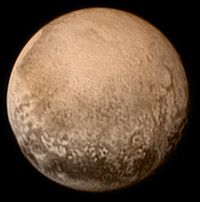
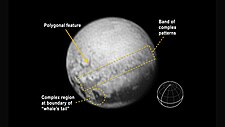
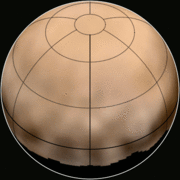

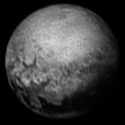

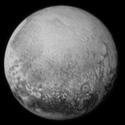
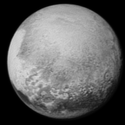
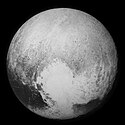
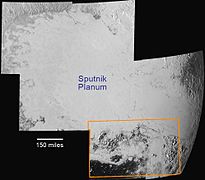

![Troughs in southern Sputnik Planitia (context) in the center left of Tombaugh Regio, representing convection cell margins. Dark spots in the troughs at lower left are pits.[26]](/upwiki/wikipedia/commons/thumb/e/e8/Troughs_in_Sputnik_Planum_by_LORRI_-_crop_of_PIA19936.jpg/180px-Troughs_in_Sputnik_Planum_by_LORRI_-_crop_of_PIA19936.jpg)

![Hillary Montes and Tenzing Montes (14 July 2015).[27]](/upwiki/wikipedia/commons/thumb/a/ad/NH-Pluto-SputnikPlanum-HillaryMontes-NorgayMontes-20150714.jpg/100px-NH-Pluto-SputnikPlanum-HillaryMontes-NorgayMontes-20150714.jpg)
![Tenzing Montes south of Tombaugh Regio (14 July 2015).[28]](/upwiki/wikipedia/commons/thumb/0/01/15-152-Pluto-NewHorizons-HighResolution-20150714-IFV.jpg/100px-15-152-Pluto-NewHorizons-HighResolution-20150714-IFV.jpg)
